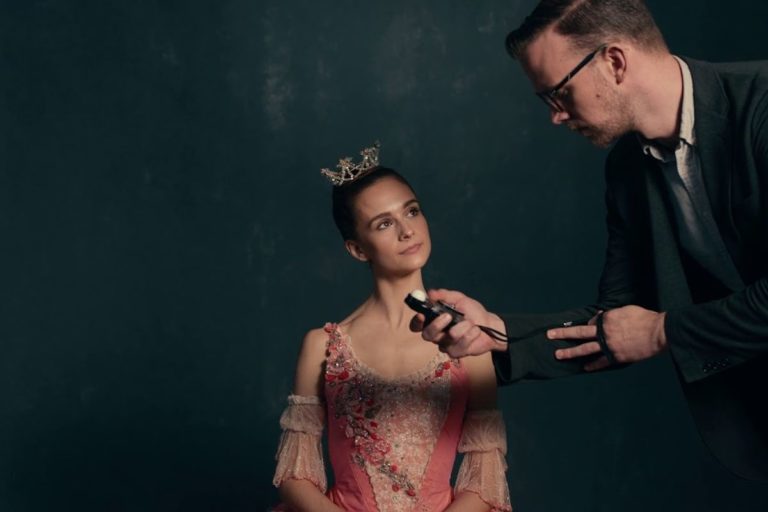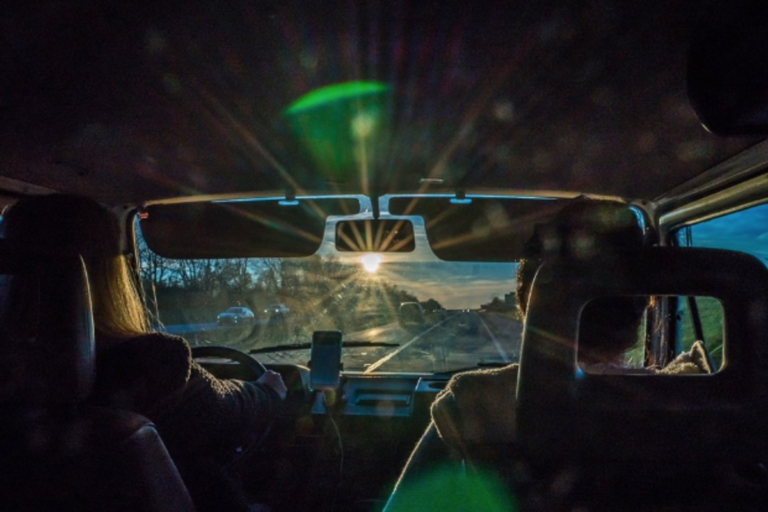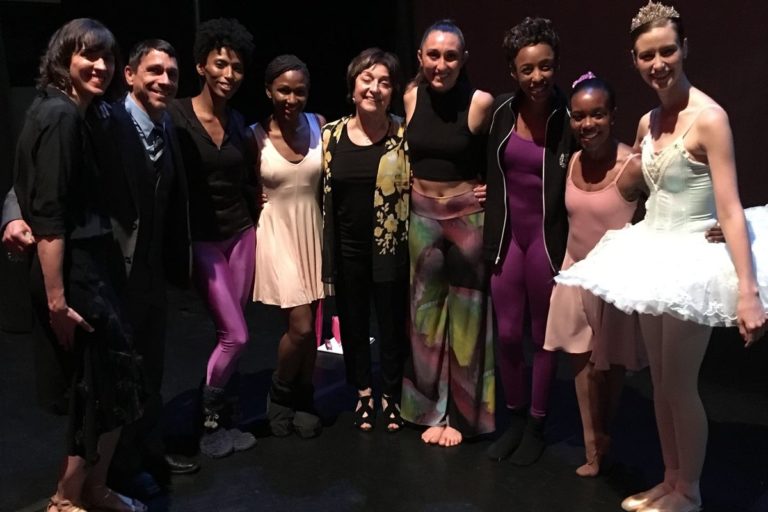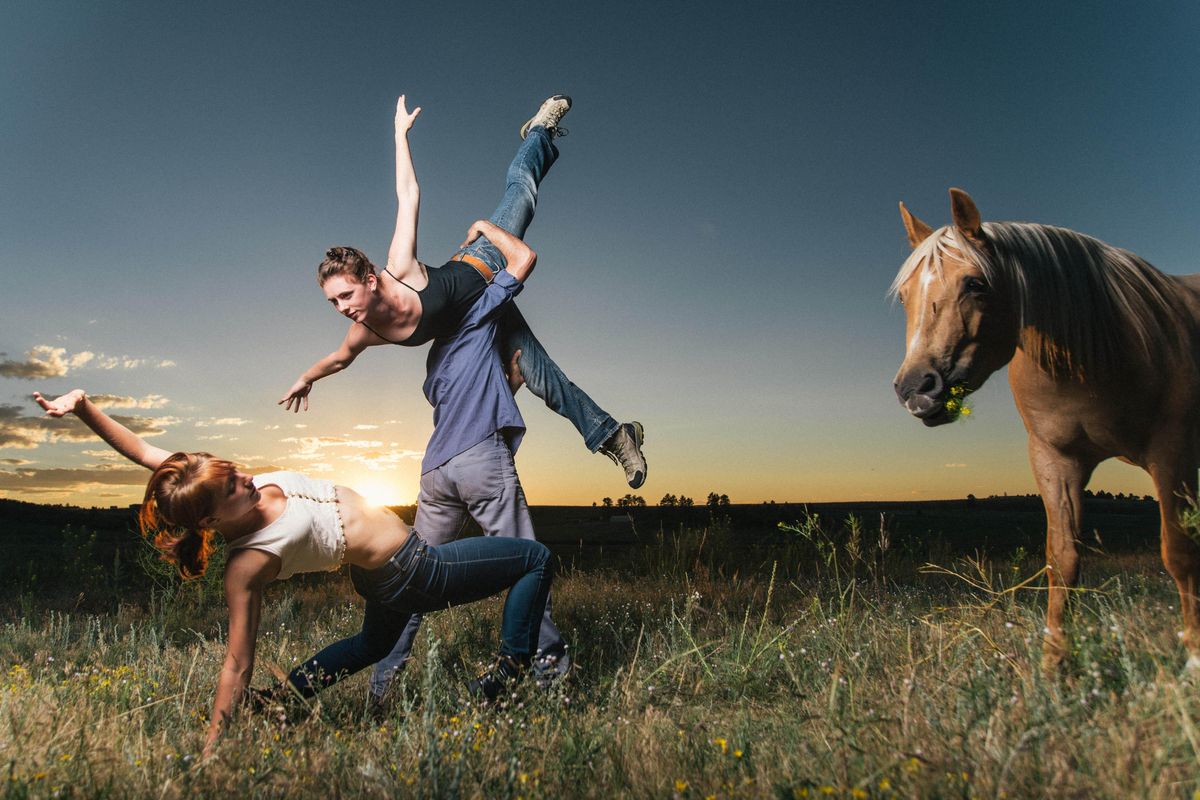
A group of dancers, clad in long maroon dresses and armed with garden rakes, are scattered over a gentle hill. Suddenly—clearly visible despite the camera’s considerable distance—two white horses appear on the hilltop. The dancers stand stock still, as if frozen in time, as a man and woman carefully lead the majestic beasts around and among the motionless dancers in a twisting pattern. At the bottom of the hill, more dancers enter a horse pen, kicking up dirt and darting in front of and around three chestnut horses, close enough to touch their muzzles and swishing tails. Soon the dancers sprint in a circle, occasionally diving and sliding to the dirt, with the horses at a fast clip behind them. It’s a game both playful and perilous. One dancer stays on the ground, rolling, spiraling and twisting in the dirt, as the 1,500-pound equines gallop ever faster toward him. At the last second, the horses halt, just inches from crushing him beneath their hooves. It’s a dangerous, exhilarating and magical spectacle.
This is a scene from choreographer JoAnna Mendl Shaw’s Un/Stable Landscape, a piece she created in summer 2011 at the Bates Dance Festival. At a nearby farm, Shaw’s company, The Equus Projects, joined forces with the Minneapolis-based company Black Label Movement and students from Bates to craft a thrilling study in movement and unspoken communication with their five equestrian partners.
Though the partnership between man and horse is centuries old, it’s typically one of horse and rider. But Shaw isn’t interested in the typical. She’s spent the last 18 years creating more than 40 works for dancers and horses, in which the dancers aren’t astride their equine partners, but alongside them on the ground. Along the way, she’s mined what she’s discovered about horse behavior for her approach in the classroom, teaching conservatory students the power of being in the moment.
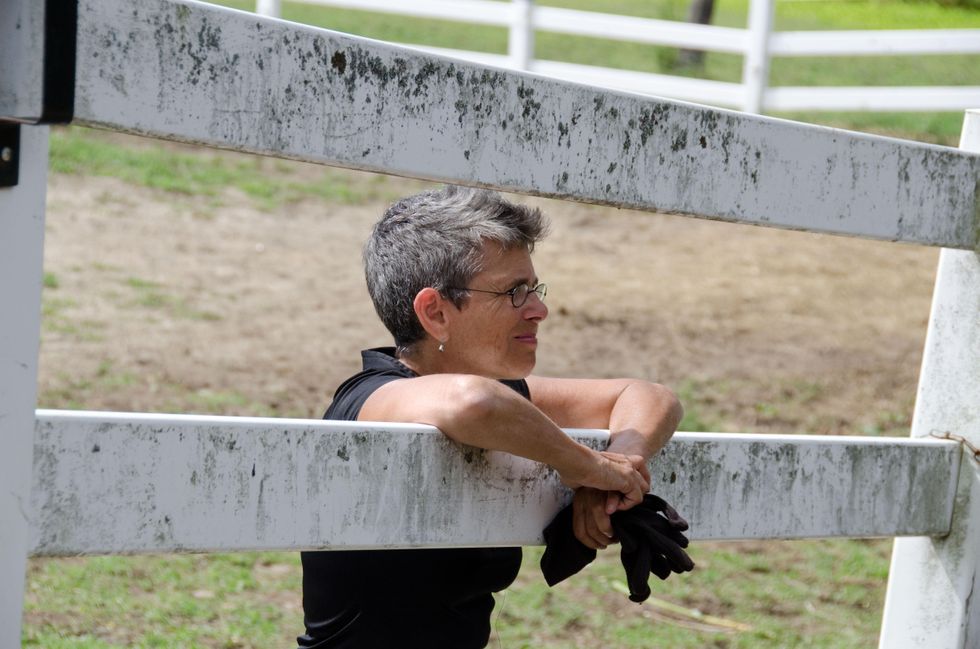 JoAnna Mendl Shaw. Photo by Arthur Fink, courtesy of Shaw
JoAnna Mendl Shaw. Photo by Arthur Fink, courtesy of Shaw
A Horse of a Different Color
Little in Shaw’s own dance history indicated that she would pursue an eclectic performance path. “My trajectory was: classical dance training, obedient dancer, really good at learning repertory and doing the same steps over and over again,” she says. After attending Mount Holyoke College and dancing on and off-Broadway in New York and choreographer Bill Evans’ modern dance company in Seattle, she gradually transitioned into choreography. “I wanted to learn how to choreograph—so I formed my own company. I thought it would be a way of learning,” she says.
In 1997, Mount Holyoke invited Shaw to create a piece for the Five College Dance Department’s 20-year anniversary. At the time, she’d been experimenting with site-specific work. “I became intrigued by the fact that Mount Holyoke had a fabulous equine studies department,” she says. She decided to create a work with the horses boarded at the school’s equestrian center.
When the equestrian director showed her dressage videos, in which horses are trained to complete specific movements, like a particular gait or turns, Shaw thought to herself, “This is like watching grass grow.” She was much more interested in the horses in a freer state: rolling, kicking and bucking. That fall, she made three horse works. One, Body on Body, paired the Mount Holyoke dressage team and their horses with dancers.
“I didn’t know what I was doing,” she says, remembering her earliest attempts. “The dancers would move with their hand on the horses’ shoulders. We devised ways of coming around the nose to change sides, coming around the haunches safely, staying out of the kick zone.” The horses quickly learned to read the dancers’ movement. “After a while, the horses would stop paying attention to the rider, and you’d see their ear go to the dancer,” she says. “I remember the riders saying, ‘I didn’t tell that horse to turn right!’
Straight from the Horse’s Mouth
Excited by what she’d learned at Mount Holyoke, Shaw began studying horse behavior. She was approached by a trainer in natural horsemanship (sometimes called horse whispering). He had heard about her work and was eager to train Shaw and her dancers how to interact with the horses without riding them. They began rehearsing on the ranch of Pat and Linda Parelli, founders of a natural horsemanship program. “The Parellis are like Bruce Springsteen in the horse world,” says Shaw. “They paid for our equipment and for us to come to their courses.”
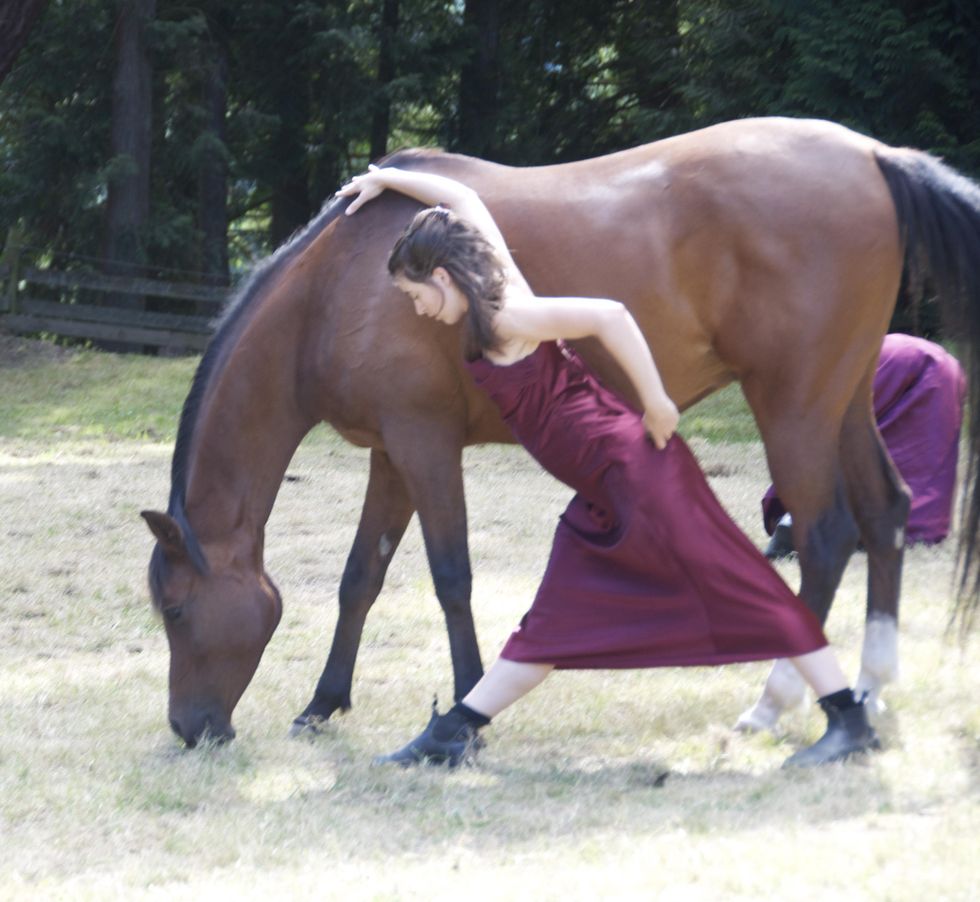 For Dancing in Real Time (2010), Shaw partnered Carlye Eckert and two others with a small herd of Polish Arabian horses in Vashon, Washington. Photo by Judith Stewart, courtesy of Shaw
For Dancing in Real Time (2010), Shaw partnered Carlye Eckert and two others with a small herd of Polish Arabian horses in Vashon, Washington. Photo by Judith Stewart, courtesy of Shaw
Shaw was constantly surprised by the horses. “We worked with this Arabian horse, Hamlet,” she remembers. “Hamlet was very smart—he basically memorized the choreography. One day, we started rehearsing, and Hamlet began to trot in a circle. Why? Because that’s the end of the piece, and he figured if he skipped to the end, he’d be done.”
Shocked, she called the trainer, who suggested she not rehearse in order. “He said, ‘Hamlet is a left-brain extrovert. They figure out everything ahead,'” she says. She quickly realized she’d need a new approach: “I thought, ‘I have to train my dancers to work out of order.'”
She now requires all of her dancers—anywhere from 2 to 14—to train with her in horsemanship ground skills and to make at least a yearlong commitment to her company. Horse time—some of it on a lead line, some at liberty (where the horse is loose), some with riders—is balanced with extensive studio time.
The company is based in New York City but spends much of its time traveling. Recent performances included a series of site-specific trios in NYC’s Union Square; a movement installation for 16 dancers in Potsdam, NY; shooting a horse-dance film in Colorado; and a work performed in Staten Island with two local ponies. The Equus Projects repertory is funded by commissions and grants, including from the Lower Manhattan Cultural Council and the National Endowment for the Arts (Shaw has received two NEA choreographic fellowships).
 Un/Stable Landscape (2011), Bates Dance Festival. Photo by Arthur Fink, courtesy of Shaw
Un/Stable Landscape (2011), Bates Dance Festival. Photo by Arthur Fink, courtesy of Shaw
Leading the Dancers to Water
Shaw considers teaching of equal importance to her work as a choreographer. As early as her days performing with Evans’ company in Seattle, she held positions at Cornish College of the Arts and the University of Washington. After moving to New York, she joined the faculties of The Juilliard School, NYU Tisch School of the Arts and the Ailey/Fordham BFA Program. But as her horse world expanded, she found herself troubled by what she observed in the studio.
“So often when dancers dance with each other, they just dance at each other,” she says. “They get bored, and they go on automatic. They don’t pay attention. With horses, it matters, because they notice everything.”
She began introducing into her classes what she’d first discovered in the arena: alpha negotiation and leadership patterns. “I’d say to one student, ‘You’re the alpha,’ and to the second, ‘You’re going to follow whatever the alpha does—just keep your eye on the alpha.” Then she’d have them swap roles; then she’d have them swap again. “Then I’d tell them, ‘Now don’t talk about who’s leading. Now try and steal leadership. Now relinquish leadership,'” she says. “It really makes you pay attention.” She eventually developed these studio games and experiments into what she calls scoring mechanisms—a set of explicit instructions that shape an improvisation.
Brittany Beyer, who danced in Equus for two years, thinks her use of these improvisatory exercises gives her a deeper understanding of the dancers she works with. “She knows her dancers so well,” says Beyer. “She’ll say, for example, ‘I’ll use you this way because I know you like to shape things from the outside.’ It’s a fantastic way of acknowledging the intelligence of your dancers.”
Champing at the Bit
And yet, getting the work produced is often an uphill battle. “I can’t get the dance world to pay attention,” Shaw says. “People think we’re doing circus—they don’t want to take the time to find out. It’s a very tough sell.” She recently left her teaching jobs to focus full-time on her company. She has both horse and site-specific projects planned in Chicago, Santa Fe and Sedona, Arizona, later this year.
But she remains committed to a broader view of dance education. “I’ve spent my life training these amazing young dancers, and only a small fraction of them will get to work in the field,” she says. “But what if we expanded the notion of the field? We all stand in front of the mirror and count to eight. I think that’s limiting. Dancers need to have a plastic intellect, to integrate thinking and sensing more. If they did, they’d see the possibilities for dance to live in many different ways.”

